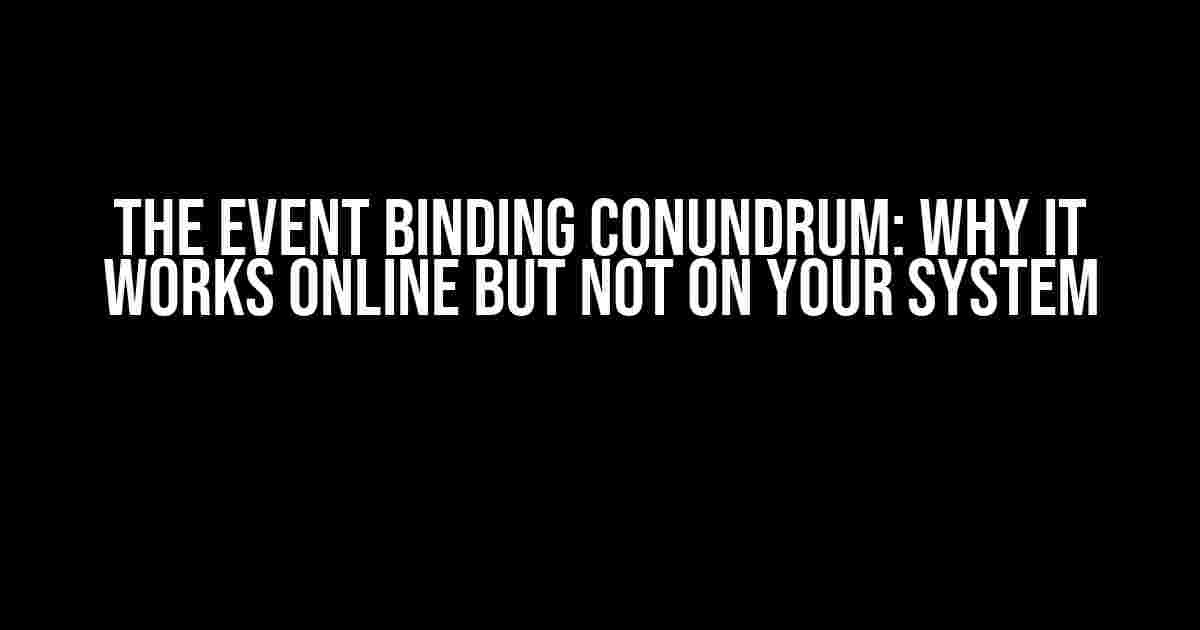Are you plagued by the frustrating phenomenon where your event binding works like a charm on an online compiler, but refuses to function on your local system? You’re not alone! This article delves into the world of event binding, exploring the possible reasons behind this discrepancy and providing step-by-step solutions to get your event binding working on your system.
Understanding Event Binding
Before we dive into the troubleshooting process, let’s quickly review what event binding is. Event binding is a fundamental concept in web development, allowing developers to attach an event listener to an HTML element. This listener responds to specific events, such as clicks, hover overs, or key presses, and triggers a function or set of functions.
<button id="myButton">Click me!</button>
<script>
const button = document.getElementById("myButton");
button.addEventListener("click", function() {
console.log("Button clicked!");
});
</script>In the example above, we attach a click event listener to the button element using the addEventListener method. When the button is clicked, the function logs “Button clicked!” to the console.
The Online Compiler Enigma
- Sandboxed Environment: Online compilers operate in a sandboxed environment, which means they have limited access to system resources and are isolated from the local file system. This isolation can affect how event binding behaves.
- Version Discrepancies: Online compilers often use the latest versions of JavaScript and HTML, which may not be the case on your local system. Version differences can lead to inconsistencies in event binding.
- Browser Differences: Online compilers usually run on a specific browser or browsers, whereas you might be using a different browser on your local system. Browser differences can impact event binding.
- Code Optimization: Online compilers might optimize your code, which can affect event binding. On your local system, you might not be using the same optimization techniques.
Troubleshooting Steps
Now that we’ve identified the possible causes, let’s go through a series of troubleshooting steps to get your event binding working on your system:
Step 1: Verify Your Code
Double-check your code for any syntax errors or typos. Ensure that you’re using the correct event listener method (addEventListener) and that the event listener is attached to the correct element.
<button id="myButton">Click me!</button>
<script>
const button = document.getElementById("myButton");
button.addEventListener("click", function() {
console.log("Button clicked!");
});
</script>Step 2: Check Browser Compatibility
Ensure that you’re using a compatible browser. If you’re using an older browser, try updating to the latest version or switching to a different browser.
Step 3: Inspect Your HTML Structure
Verify that your HTML structure is correct and that the element you’re trying to bind the event to exists in the DOM. Use the browser’s developer tools to inspect the element and ensure it’s not dynamically generated.
| Browser | Developer Tools |
|---|---|
| Google Chrome | Press F12 or Right-click > Inspect |
| Mozilla Firefox | Press F12 or Right-click > Inspect Element |
| Microsoft Edge | Press F12 or Right-click > Inspect |
Step 4: Check for JavaScript Errors
Open your browser’s console and check for any JavaScript errors. If you find any errors, resolve them and try running your code again.
console.log("Button clicked!"); // Ensure there are no errors in your codeStep 5: Verify Event Listener Attachment
Use the browser’s developer tools to verify that the event listener is attached to the element. You can do this by:
- Inspecting the element in the Elements tab
- Switching to the Event Listeners tab
- Verifying that the event listener is listed under the corresponding event (e.g., “click”)
Step 6: Check for Conflicting Code
Ensure that there’s no conflicting code that might be overriding your event binding. Check for any other event listeners attached to the same element or its parent elements.
<script>
// Ensure there's no conflicting code like this
document.getElementById("myButton").onclick = function() {
console.log("Conflicting code!");
};
</script>Step 7: Try a Different Approach
If all else fails, try using a different approach to event binding. Instead of using addEventListener, try using the onclick attribute:
<button id="myButton" onclick="console.log('Button clicked!');">Click me!</button>If this approach works, it might indicate that there’s an issue with your JavaScript code or the way you’re attaching the event listener.
Conclusion
The event binding conundrum can be frustrating, but by following these troubleshooting steps, you should be able to identify and resolve the issue. Remember to verify your code, check browser compatibility, inspect your HTML structure, and eliminate any conflicting code. If you’re still stuck, try a different approach to event binding. With persistence and patience, you’ll get your event binding working on your system in no time!
If you have any further questions or concerns, feel free to ask in the comments below. Happy coding!
Frequently Asked Question
Having trouble with event binding on your local system, but it’s working like a charm on an online compiler? You’re not alone! Let’s dive into some common solutions to get you back on track.
Q1: Is my code correct? Could there be a syntax error?
Double-check your code, my friend! Syntax errors can be sneaky. Make sure you’re not missing any brackets, quotes, or semicolons. If you’re still unsure, try debugging your code or running it through a linter to catch any errors.
Q2: Are my event listeners correctly attached to the DOM elements?
Hmmm, good point! Ensure that your event listeners are attached to the correct DOM elements and that those elements exist when the script is executed. Try using the `document.addEventListener(“DOMContentLoaded”, function(){…})` method to ensure your script runs after the DOM has finished loading.
Q3: Am I using the correct JavaScript file or library?
Ah-ha! Make sure you’re using the correct JavaScript file or library. Are you using a CDN link or a local copy? Try switching to a different source or version to see if that resolves the issue. Also, ensure that your JavaScript file is being loaded correctly and in the correct order.
Q4: Are there any browser or security restrictions blocking my event binding?
Security can be a real party pooper! Check if your browser or system has any restrictions in place that might be blocking your event binding. Try running your code in a different browser or environment to see if the issue persists.
Q5: Have I cleared my browser cache and tried a hard reload?
The classic “have you tried turning it off and on again” solution! Clear your browser cache and try a hard reload ( CTRL + SHIFT + R or CMD + SHIFT + R ) to ensure that you’re getting the latest changes.


